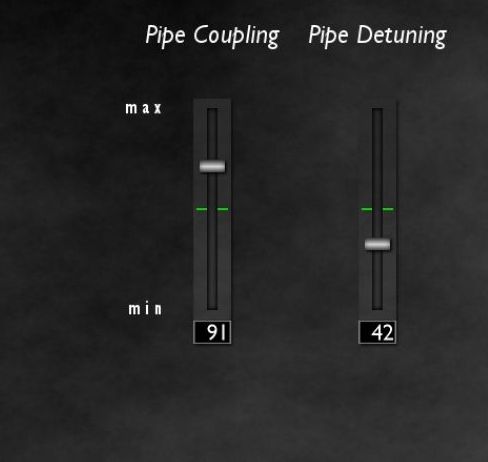We all know this phenomenon from playing a real pipe organ. Every organ in the world is always a little bit out of tune, perfectly tuned organ does not exist. And in spite of that, when played, the organ does not sound terrible. One reason is pipe coupling phenomenon. The pipes start to sound a bit out of tune, but they quickly try to come together to be almost in tune. Obviously, sometimes the pipes do not succeed and beating occurs, but as the result of the pipe coupling, the organ sounds usually less out of tune than one would expect.
The most important aspect of the pipe coupling is the observation, that the beating of the pipes is not constant, but becomes less prominent when the key is held for longer time (within a span of a first second or so) . This brings incredible movement and live to the organ sound. This phenomenon seems important for the realism of the organ sound model.
Obviously, one can argue, that different windchest layouts cause different pipe coupling scheme, and one would need various ways of implementing the pipe coupling feature. Yes, perhaps in future. To my experience, this phenomenon occurs on every organ to some extent. And the enhancement of the digital model by the introduction of the pipe coupling effect is drammatic. Therefore, I decided to enable this feature in all my sample sets, time allowing.
I do hear the criticism sometimes, that my organ models sound too perfect, too much in tune, which is not realistic. The random tuning error in Hauptwerk could be a nice feature, but it is static, and it brings beating even between the audio channels of the same pipe, which is also not realistic. Therefore, this function must be set to 0 to prevent it. When the Original Organ Tuning is used, it is not that bad, because some beating is heard, but when any other temperament is used, the organ sounds digital, static and perhaps "thin", because of the absense of casual tuning errors and the resulting chorus effect so much characteristic for a real pipe organ.
The pipe coupling feature brings the change. It introduces a dynamic chorus effect. In this way, it brings new level of realism to the virtual organ models of Sonus Paradisi.
Nevertheless, there are different users, and some want to hear the sound clean, transparent and in tune completely. Therefore, the Pipe Coupling feature is user controllable: visit the Mixer tab and see the slider for the Pipe Coupling. In the min. position, the Pipe Coupling effect is off and the organ best in tune.
(The other slider called Pipe Detuning serves to adjust the overall random mistuning of all the pipes. When at minimum, the organ is perfectly in tune, when at maximum, the organ sound very much out ot tune. In some sample sets, this feature is included in the Pipe Coupling slider, in other sample sets, it is an independent slider.)
Listen to the three examples, recorded with the St. Martini, Groningen, Surround sample set.
BWV 532 (excerpt) - pipe coupling effect set minimum
- Pipe coupling set to the value 1 (minimum), effectively switched off. No pipe coupling heard, the organ is best in tune possible, but perhaps the organ sound gets too "slim" or "boring" because of the perfect pipe tuning.
BWV 532 (excerpt) - pipe coupling effect set default
- The pipe coupling effect in the default position - "chorus" effect on the pipe attack heard mild, giving rich, broad, vibrant organ sound result.
BWV 532 (excerpt) - pipe coupling effect set maximum
- The pipe coupling effect set to its maximum. The organ is too much out of tune (clearly exaggerated), but still playable and the effect is very well heard for better understanding of its nature.

